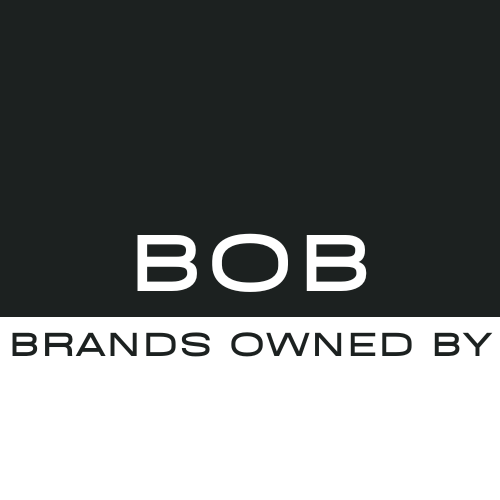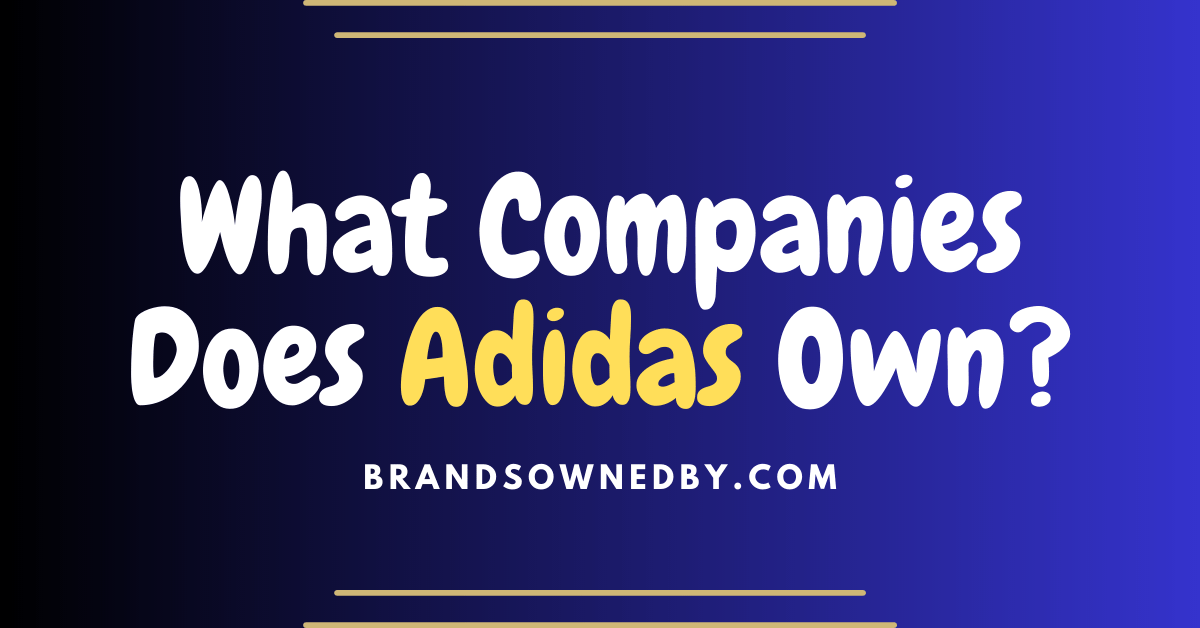What companies does Adidas own? This is a question many fans of the global sportswear giant often ask. Adidas is more than just a shoe and apparel brand. It has built a diverse portfolio over decades, owning or operating multiple brands in footwear, sports gear, fashion, and technology. Each company under the Adidas umbrella has contributed to its massive influence in the global sportswear and fashion industry.
Adidas Company Profile

Adidas is one of the world’s largest sportswear manufacturers, known globally for its three-stripe logo. The company designs, manufactures, and sells footwear, apparel, and accessories for sports, fashion, and lifestyle markets. With a global presence and strong brand recognition, Adidas continues to shape the sportswear industry through innovation, collaborations, and sustainability efforts.
Company Details
- Full Name: Adidas AG
- Founded: August 18, 1949
- Headquarters: Herzogenaurach, Bavaria, Germany
- Industry: Sportswear, Apparel, Footwear, Accessories
- Stock Ticker: ADS (Frankfurt Stock Exchange)
- Employees: Over 59,000 (as of 2025)
- Global Reach: Products sold in over 160 countries
- Subsidiaries: Five Ten, Runtastic, Adidas Golf, Y-3 (collaboration).
Adidas operates through several divisions, including Adidas Performance (sports gear), Adidas Originals (lifestyle and heritage products), and Adidas Terrex (outdoor and adventure gear). Its business model includes wholesale, e-commerce, and own-brand retail stores.
Adidas Founders
Adidas was founded by Adolf “Adi” Dassler in 1949. Adi Dassler was a German cobbler and sports enthusiast who initially worked with his brother Rudolf Dassler under the brand “Gebrüder Dassler Schuhfabrik” (Dassler Brothers Shoe Factory).
After a personal and business split, Rudolf founded Puma, while Adi formed Adidas. The name “Adidas” was derived from Adi’s own name: Adi + Das(sler). Their rivalry gave birth to two of the biggest sportswear brands in history, both headquartered in the same small German town.
Major Milestones
- 1924: Dassler Brothers Shoe Factory is founded, supplying shoes to Olympic athletes.
- 1949: Adi Dassler registers Adidas and introduces the iconic 3-stripe logo.
- 1954: Adidas gains global fame when the German football team wins the World Cup wearing Adidas cleats.
- 1970: Adidas provides the official match ball for the FIFA World Cup, a partnership that continues today.
- 1986: Adidas signs a groundbreaking endorsement deal with Run-D.M.C., linking sportswear with hip-hop culture.
- 1995: Adidas becomes a publicly listed company on the Frankfurt Stock Exchange.
- 2006: Adidas acquires Reebok, aiming to expand its U.S. market presence.
- 2015: Adidas launches its first 3D-printed shoe and enters the fitness tech space by acquiring Runtastic.
- 2017: Adidas becomes the most talked-about brand in sneaker culture thanks to Yeezy and Originals.
- 2021: Adidas announces it will sell Reebok to focus on its core brand.
- 2023: Bjørn Gulden becomes CEO and initiates a business turnaround strategy.
- 2025: Adidas regains momentum with revived classics, digital fitness growth, and outdoor market expansion.
Who Owns Adidas: List of Shareholders
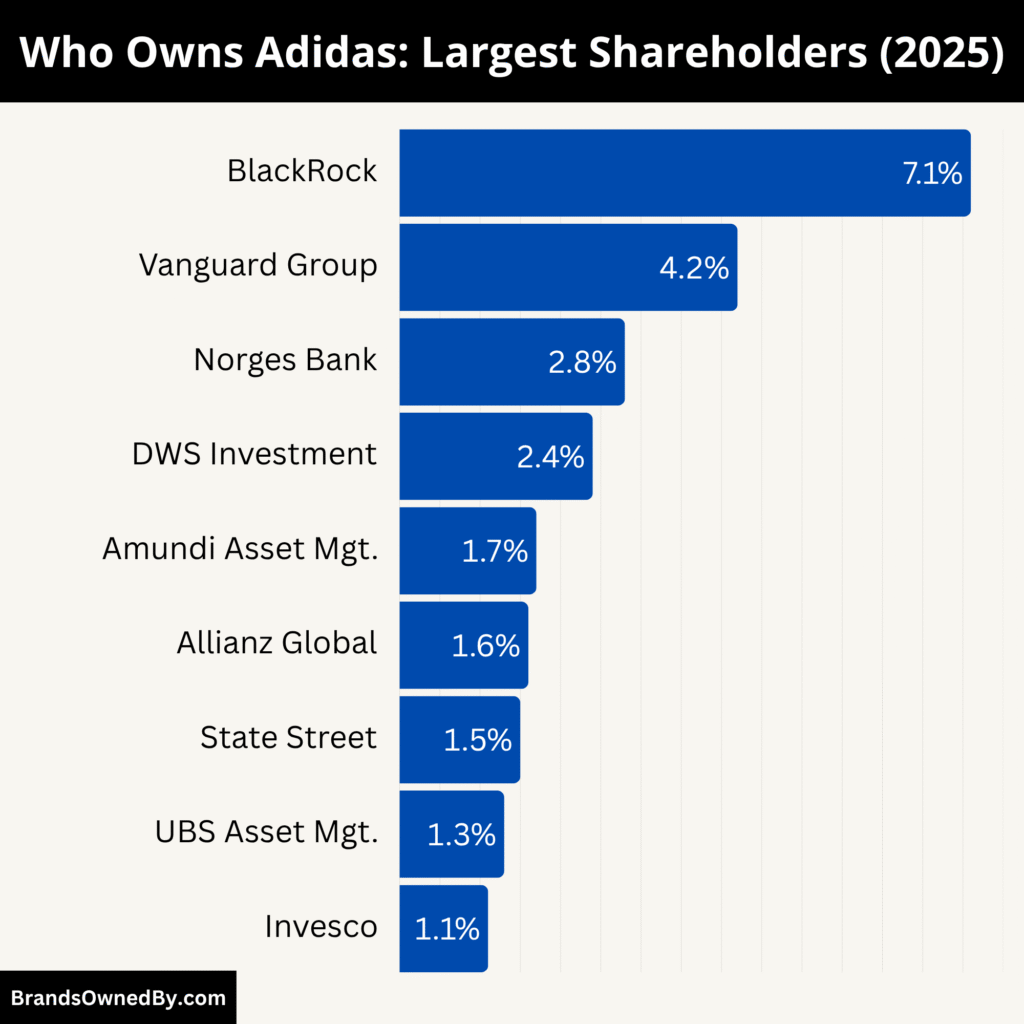
Adidas AG is a publicly traded company listed on the Frankfurt Stock Exchange. No individual or founding family currently controls it. Instead, ownership is widely distributed among institutional investors, mutual funds, retail shareholders, and company-held shares.
Below is a list of the largest shareholders of Adidas:
BlackRock Inc. – ~7.1%
BlackRock Inc., the world’s largest asset manager, is the largest single shareholder of Adidas.
As of 2025, it owns approximately 7.1% of the company. This represents a significant stake, giving BlackRock strong influence during shareholder votes, particularly in matters related to sustainability, corporate governance, and executive pay.
BlackRock is known for being an activist investor, and it often pushes companies to align with ESG (Environmental, Social, and Governance) goals. Its consistent investment in Adidas signals confidence in the brand’s long-term value and global presence.
Norges Bank Investment Management – ~5.15%
Norges Bank Investment Management (NBIM), which manages Norway’s Government Pension Fund Global (one of the world’s largest sovereign wealth funds), owns about 5.15% of Adidas shares. This fund invests globally to safeguard wealth for future generations of Norwegians. NBIM is known for its strict investment ethics, including a focus on labor practices, environmental footprint, and corporate accountability. Adidas’ sustainability commitments and global strategy make it a suitable holding for NBIM.
Capital Research & Management Company – ~4.9%
Capital Research & Management Company, part of Capital Group, holds approximately 4.9% of Adidas. As one of the oldest and most respected investment firms in the U.S., Capital Group generally makes long-term strategic investments in companies with high global visibility and consistent earnings growth. Its stake in Adidas indicates belief in the brand’s recovery and growth under its new leadership and product revitalization.
The Vanguard Group – ~4.07%
Vanguard is another global giant in asset management and mutual fund operations. It owns roughly 4.07% of Adidas shares in 2025. Vanguard is known for passive index investing and is often the second or third largest shareholder in many global public companies.
Its investment in Adidas is part of its exposure to the consumer discretionary and global apparel sectors. Vanguard’s presence contributes to Adidas’ stability, especially as it realigns its strategy post-Yeezy and post-Reebok.
Groupe Bruxelles Lambert (GBL) – ~3.54%
Groupe Bruxelles Lambert, a Belgian holding company, owns about 3.54% of Adidas. GBL is a long-term investor focused on European blue-chip companies. Its stake in Adidas reflects its strategy of investing in well-established, high-performance companies.
GBL tends to support companies with strong brand equity, financial discipline, and a global footprint. It also has a history of influencing governance decisions through board representation or engagement.
Amundi Asset Management – ~3.17%
Amundi is Europe’s largest asset manager and owns approximately 3.17% of Adidas as of 2025. Based in Paris, Amundi invests heavily in global equities with a strong focus on ESG. Its stake in Adidas aligns with its portfolio strategy of supporting sustainable brands that appeal to younger, eco-conscious consumers. Adidas’ use of recycled materials and push toward climate neutrality make it attractive to investors like Amundi.
Flossbach von Storch – ~2.85%
Flossbach von Storch, a private asset management firm based in Germany, holds close to 2.85% of Adidas. It focuses on quality-oriented, long-term investment strategies. Being a German firm, it likely has deeper insights into Adidas’ local market operations and leadership culture. The company’s stake in Adidas reflects its confidence in Adidas as one of Germany’s flagship consumer brands.
Union Investment (Union Asset Management Holding AG) – ~2.38%
Union Investment is the investment arm of Germany’s cooperative financial sector and owns about 2.38% of Adidas. It focuses on reliable dividend-paying companies with strong governance practices. Union Investment often supports policies around labor rights, diversity, and ethical sourcing—areas where Adidas has made visible efforts.
Mutual Funds and ETFs – ~42–43%
Mutual funds and exchange-traded funds (ETFs) hold a combined 42% to 43% of Adidas’ outstanding shares. These funds include index-based products like the iShares MSCI World ETF, Vanguard FTSE Developed Markets ETF, and DWS Top Dividende, which feature Adidas due to its large market capitalization and industry relevance.
These funds bring passive capital to Adidas and help ensure stock liquidity. While they do not actively manage the companies they invest in, their vote still counts during major decisions, such as executive appointments and annual reports.
Public and Retail Shareholders – ~47–48%
Retail investors, employee shareholders, and other public participants together own nearly 47–48% of Adidas shares. This includes global investors buying through brokerage accounts or retirement portfolios, as well as small funds or financial cooperatives. Although this group does not individually influence corporate governance, collectively it represents a major vote in annual general meetings (AGMs) and is crucial to share price stability.
Treasury Shares – ~0.8%
Adidas itself owns approximately 0.8% of its shares in treasury. These are not included in voting rights and may be used for future stock-based employee compensation programs, share buybacks, or other corporate finance strategies. This also helps control dilution of existing shareholders.
List of Companies Owned by Adidas
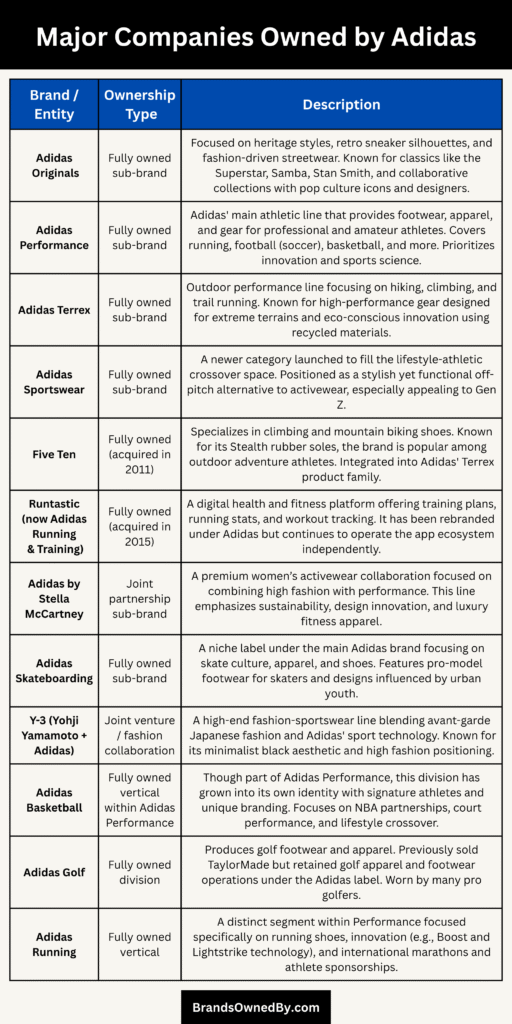
As of 2025, Adidas operates as a standalone global sportswear corporation. It directly owns and manages a portfolio of performance-driven and fashion-oriented brands. Adidas has undergone several acquisitions and divestitures to sharpen its focus.
Below is a list of the major companies, brands, and entities owned by Adidas as of July 2025:
| Brand/Entity | Type | Year Acquired/Launched | Description | Special Focus |
|---|---|---|---|---|
| Adidas Originals | Brand/Division | 2001 (launched) | Lifestyle and fashion line inspired by Adidas heritage | Retro sneakers, streetwear, celebrity collaborations |
| Adidas Performance | Core Brand Division | Core brand (since 1949) | High-performance athletic wear and footwear | Running, football, basketball, tennis, gym training |
| Adidas Terrex | Brand/Sub-division | 2011 (launched) | Outdoor sports division under Adidas | Hiking, trail running, mountain sports |
| Five Ten | Subsidiary Brand | Acquired in 2011 | Outdoor and climbing footwear brand | Rock climbing, mountain biking, approach shoes |
| Y-3 | Co-branded Fashion Label | Launched in 2002 | Avant-garde fashion collaboration with Yohji Yamamoto | High-end sports-luxury fashion |
| Adidas Golf | Sub-division | Retained after TaylorMade sale (2017) | Golf footwear and apparel | Technical golf clothing, tour player endorsements |
| Runtastic | Acquired Company (now rebranded) | Acquired in 2015 | Fitness app integrated into Adidas Running and Training apps | Fitness tracking, digital workouts, app ecosystem |
| Adidas Skateboarding | Brand Line | Launched in 2006 | Skate-specific shoes and apparel | Street skatewear, pro skater collabs |
| Adidas Team | Division | Longstanding internal division | Uniforms and kits for teams and institutions | Custom teamwear, sports kits for clubs and schools |
| Confirmed App | Digital Platform | Launched in 2020 | Mobile app for exclusive Adidas product drops | Limited releases, hype drops, sneaker raffles |
Adidas Originals
Adidas Originals is a lifestyle and fashion brand under the Adidas Group. It was introduced to preserve the company’s classic and iconic designs such as the Stan Smith, Superstar, and Gazelle sneakers. While not a separate legal entity, it functions as an independent division with its own creative direction.
Adidas Originals plays a major role in streetwear culture. It collaborates with artists, designers, and celebrities, contributing heavily to Adidas’ appeal among Gen Z and millennial consumers. Its most iconic partnerships included those with Kanye West (Yeezy, now discontinued), Pharrell Williams, and Bad Bunny.
In 2025, the brand continues to thrive through nostalgia-driven reissues, eco-friendly versions of classics, and global marketing campaigns targeting fashion-forward consumers.
Adidas Performance
Adidas Performance is the core division responsible for high-performance sportswear. It includes products for football, running, basketball, tennis, training, and more. The division emphasizes innovation in materials, athlete-centered design, and sports science.
Adidas Performance partners with global sports leagues, Olympic teams, and elite athletes. Notable product lines include Ultraboost, Predator football boots, Adizero running shoes, and Heat.RDY apparel. This brand segment is essential to Adidas’ revenue and reputation as a serious sportswear competitor.
Adidas Terrex
Adidas Terrex is the company’s outdoor performance brand. It produces hiking boots, trail running shoes, climbing apparel, and winter gear. Terrex was created to compete with The North Face, Salomon, and Arc’teryx in the outdoor market.
In 2025, Terrex operates semi-independently within Adidas. It has collaborated with climbers, skiers, and mountaineers. Terrex is known for its weatherproof technology, GORE-TEX membranes, and rugged, lightweight materials. The division has been rapidly expanding due to the outdoor lifestyle boom post-pandemic.
Five Ten
Five Ten is a U.S.-based climbing and biking footwear company acquired by Adidas in 2011. It is fully owned and integrated under the Adidas Outdoor umbrella, primarily operating within the Terrex division.
Five Ten is known for its Stealth Rubber outsole technology, which provides superior grip for rock climbing and mountain biking. It retains its original name and brand identity, with most of its R&D conducted in collaboration with outdoor athletes.
By 2025, Five Ten has expanded beyond core climbing shoes to include approach shoes and biking shoes, strengthening Adidas’ dominance in the high-performance outdoor sports segment.
Y-3
Y-3 is a luxury fashion collaboration between Adidas and renowned Japanese designer Yohji Yamamoto. Launched in 2002, it combines avant-garde fashion with Adidas’ technical sportswear DNA.
Y-3 is a distinct high-end brand, often featured on fashion runways. Its all-black aesthetics, futuristic silhouettes, and premium materials appeal to luxury streetwear fans. While it remains niche, Y-3 plays a crucial role in elevating Adidas’ image as a brand that blends performance with fashion.
The Y-3 label is distributed through exclusive retail outlets, high-end department stores, and dedicated sections in Adidas’ flagship stores.
Runtastic (Adidas Running App)
Adidas acquired Runtastic in 2015 and has since transitioned it into the Adidas Running and Adidas Training apps. While the Runtastic brand name has faded, its technology remains at the core of Adidas’ digital ecosystem.
These apps track workouts, offer fitness plans, and connect users globally. In 2025, they serve as community-building tools, driving customer retention through challenges, in-app purchases, and seamless integration with wearable tech.
The digital platform also plays a vital role in Adidas’ consumer data strategy, allowing the company to deliver personalized recommendations and targeted marketing.
Adidas Golf
Adidas Golf designs and sells golf-specific apparel, footwear, and accessories. Although the company sold TaylorMade (its former golf equipment division) in 2017, Adidas retained the golf apparel and footwear business under its own name.
As of 2025, Adidas Golf is a mid-sized but profitable segment. Its products are worn by professional players across major tours, and it continues to release footwear innovations like spikeless soles and lightweight traction designs.
Adidas Golf blends technical fabrications with minimalist design, making its offerings popular both on and off the course.
Adidas Skateboarding
Adidas Skateboarding is a dedicated product line for skate culture and lifestyle. Launched as a niche segment, it has evolved into a full-fledged category offering footwear, apparel, and collaborations with pro skaters and underground designers.
It leverages classic silhouettes like the Campus and Superstar, re-engineered for skate durability. Adidas Skateboarding also has a global team of sponsored riders and supports street-level events and skate contests worldwide.
In 2025, it stands as one of the few major skate brands that balances authenticity with mass-market appeal.
Adidas Teamwear (Adidas Team)
Adidas Team is the division focused on supplying kits and uniforms to professional sports teams, schools, colleges, and institutions. It handles custom design and mass production of jerseys, training gear, and accessories.
Adidas is the official kit supplier for several national football teams and high-profile clubs. The division also includes basketball and rugby teamwear, depending on the market.
This division remains a strong pillar of Adidas’ global brand visibility, especially during international tournaments.
Confirmed App (Adidas Direct-to-Consumer)
Confirmed is Adidas’ proprietary mobile app for exclusive drops, limited-edition releases, and product launches. While not a company or separate brand, it functions as a dedicated digital marketplace.
It is central to Adidas’ direct-to-consumer strategy. It allows product reservations, raffles, personalized alerts, and storytelling around sneaker launches. Confirmed supports limited-edition Y-3 drops, Originals collections, and new collaborations.
As of 2025, Confirmed continues to grow in importance as Adidas reduces dependence on third-party retailers.
Who is the CEO of Adidas?
As of 2025, Bjørn Gulden serves as the Chief Executive Officer (CEO) of Adidas AG. He took over the role at a critical time for the company and has been instrumental in reshaping its direction, culture, and financial performance.
Background and Early Career
Bjørn Gulden was born in Norway in 1965. He holds an MBA from the Babson Graduate School of Business in the United States and a business degree from the University of Rogaland in Norway. Before entering the sportswear world, he had a brief professional football career and played for clubs in Germany and Norway.
His early business career includes executive positions in well-known companies like Helly Hansen, Pandora, and Deichmann. However, he is best known for his leadership roles in the global sports industry.
CEO of Puma (2013–2022)
Before joining Adidas, Gulden was the CEO of Puma SE from 2013 to 2022. At Puma, he successfully revitalized the brand, boosting sales, modernizing product lines, and building new celebrity and athlete partnerships. Under his leadership, Puma became profitable again and regained relevance in the competitive sportswear market.
His experience at Puma gave him deep industry insight and a reputation as a turnaround expert.
Appointment as CEO of Adidas (January 2023)
Bjørn Gulden was officially appointed CEO of Adidas in January 2023, following the departure of Kasper Rørsted. At the time, Adidas was dealing with multiple challenges, including:
- The fallout from the termination of its partnership with Kanye West and the Yeezy brand.
- Declining market share in North America and China.
- Excess inventory from previous seasons.
- Reputational damage and weakened investor confidence.
Gulden was brought in to stabilize the company, rebuild trust, and re-focus the brand on its core strengths.
Leadership Style and Strategy
Bjørn Gulden is known for his hands-on leadership, transparent communication, and deep understanding of product, retail, and consumer behavior. Since taking over, his leadership style has emphasized:
- Rebuilding wholesale partnerships and improving retail channel efficiency.
- Focusing on Adidas’ classics, such as Samba, Gazelle, and Spezial.
- Scaling down unprofitable partnerships and redirecting investment to in-house brands.
- Strengthening Adidas Originals and Terrex divisions for lifestyle and outdoor appeal.
- Enhancing operational discipline by managing inventory and reducing markdowns.
- Accelerating digital direct-to-consumer sales, particularly through the Confirmed app.
Gulden has also focused on re-establishing employee morale, fostering internal innovation, and simplifying processes across the company.
Impact on Adidas (2023–2025)
Since Gulden’s appointment, Adidas has made a noticeable turnaround. By 2025:
- Revenue has rebounded due to stronger performance in lifestyle and outdoor segments.
- Adidas’ market share in Europe and Latin America has grown.
- Legacy product lines like Samba, Spezial, and Gazelle have seen a massive global resurgence.
- The company has increased its focus on sustainability, aligning with global ESG goals.
- Investor sentiment has improved, with Adidas’ stock recovering much of its lost value.
Gulden has effectively realigned Adidas’ identity: not only as a sportswear giant but also as a culture-shaping brand with roots in both sport and street fashion.
Current Role and Vision for the Future
As CEO in 2025, Bjørn Gulden’s vision is focused on long-term brand equity. He continues to:
- Invest in timeless product design.
- Push deeper into digital fitness and connected retail experiences.
- Strengthen Adidas’ relationship with athletes, creators, and everyday consumers.
- Drive operational efficiency without sacrificing creativity.
He is also preparing the company to withstand economic headwinds by focusing on core profitability and reducing reliance on short-term collaborations.
Under Gulden’s leadership, Adidas has regained direction and credibility—two elements it was losing in the years before his arrival.
Adidas Annual Revenue and Net Worth
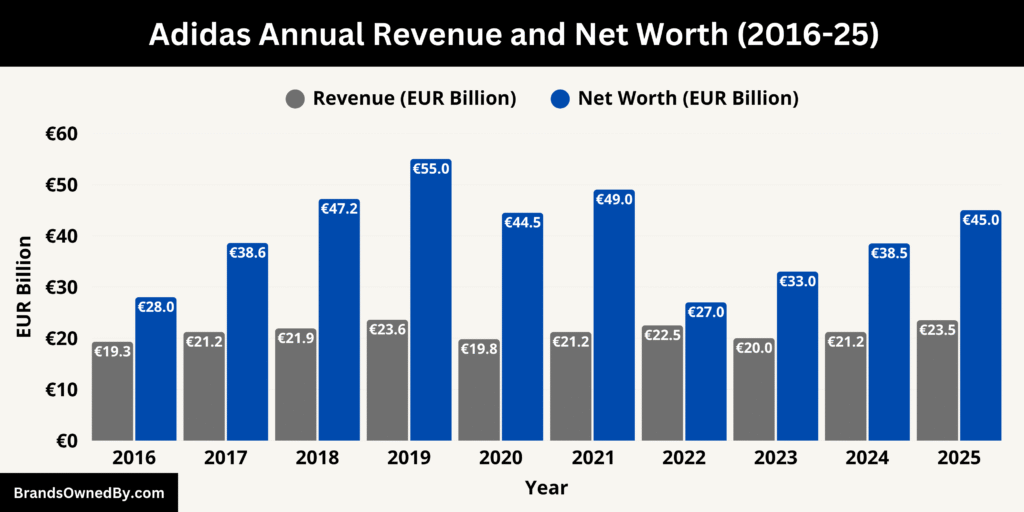
In 2025, Adidas AG showed strong signs of financial recovery and strategic realignment under the leadership of CEO Bjørn Gulden. After facing setbacks in previous years, the company has rebuilt its momentum through renewed focus on core products, effective supply chain management, and strong performance in key global markets.
Here’s a summary of Adidas’ financials as of July 2025:
| Financial Metric | 2025 Value |
|---|---|
| Annual Revenue | €23.5 billion |
| Operating Profit | €2.1 billion |
| Net Profit | €1.5 billion |
| Operating Margin | ~9% |
| Market Capitalization | €45 billion |
| Total Assets | €23.2 billion |
| Shareholders’ Equity | €10.8 billion |
| Direct-to-Consumer Revenue | €7.1 billion |
2025 Revenue Performance
As of the end of the fiscal year 2025, Adidas reported annual revenues of approximately €23.5 billion. This marks a steady increase from 2024 and reflects the company’s renewed strength in both wholesale and direct-to-consumer (DTC) channels.
Key Revenue Drivers in 2025
- Adidas Originals and Lifestyle: Legacy products like Samba, Gazelle, and Spezial have seen a massive global resurgence, driving lifestyle category growth.
- Outdoor and Performance: Terrex and Five Ten posted strong double-digit growth due to global interest in hiking, climbing, and outdoor fitness.
- E-commerce and DTC: Adidas’ online sales and mobile platforms (including the Confirmed app) now contribute over 30% of total revenue, benefiting from personalized product drops and exclusive launches.
- Emerging Markets: Latin America and Southeast Asia have become important revenue contributors, with increasing demand for mid-range sportswear.
- Footwear: Footwear remains the largest category, accounting for more than 55% of total sales globally.
Regional Breakdown (2025)
- Europe: ~€7.2 billion – Adidas’ strongest market with healthy growth in fashion-forward and sustainability-focused products.
- North America: ~€5.6 billion – Recovered after previous losses, aided by smart pricing and focused distribution.
- Asia-Pacific: ~€5.0 billion – Growth driven by digital channels and youth-oriented marketing.
- Latin America & Emerging Markets: ~€2.3 billion – Fastest-growing region, especially in Mexico, Brazil, and Chile.
- Online Direct-to-Consumer (DTC): ~€7.1 billion – Driven by exclusive drops, app purchases, and repeat customers.
Operating Profit and Margins
In 2025, Adidas achieved an operating profit of approximately €2.1 billion, reflecting an improved operating margin of around 9%. This is an improvement over 2023 and 2024 when margins were squeezed due to excess inventory and partnership terminations.
The recovery in margins is attributed to:
- Controlled promotional activity
- Efficient inventory turnover
- Increased full-price sales through DTC channels
- Lower return rates through better fit and sizing tools on online platforms.
Adidas reported a net profit of around €1.5 billion in 2025. This reflects strong financial discipline, increased consumer loyalty, and the success of core product relaunches.
Adidas Net Worth and Market Capitalization
As of July 2025, Adidas’ market capitalization is estimated at €45 billion. This marks a strong recovery from the dip experienced in 2022–2023, which was caused by the termination of major partnerships and inventory write-downs.
Factors Driving Market Value in 2025
- Investor Confidence: Renewed investor interest due to steady revenue and profit growth.
- Product Resurgence: High-margin products like Samba and Spezial contributed to stable earnings.
- Leadership Stability: The appointment of Bjørn Gulden and his effective execution strategy has reassured markets.
- Sustainability & Innovation: Expansion of circular product lines and sustainable materials has positioned Adidas as a future-ready brand.
Here is the historical revenue and estimated net worth (market capitalization) of Adidas AG for the last 10 years from 2016 to 2025:
| Year | Revenue (€ Billion) | Estimated Net Worth / Market Cap (€ Billion) |
|---|---|---|
| 2025 | 23.5 | 45.0 |
| 2024 | 21.2 | 38.5 |
| 2023 | 20.0 | 33.0 |
| 2022 | 22.5 | 27.0 |
| 2021 | 21.2 | 49.0 |
| 2020 | 19.8 | 44.5 |
| 2019 | 23.6 | 55.0 |
| 2018 | 21.9 | 47.2 |
| 2017 | 21.2 | 38.6 |
| 2016 | 19.3 | 28.0 |
Adidas Total Assets and Equity (2025)
- Total Assets: Estimated at €23.2 billion in 2025.
- Shareholders’ Equity: Approximately €10.8 billion, reflecting strong capital health and reinvestment capacity.
Adidas continues to maintain a moderate debt-to-equity ratio, with long-term liabilities decreasing year-over-year. This is a result of improved cash flows, better inventory control, and disciplined spending.
Final Words
Adidas owns several unique companies and brands that add depth to its global identity. From the tech-forward Runtastic to the edgy fashion of Y-3, Adidas has grown beyond just sportswear. It is a powerhouse in lifestyle, fitness, and innovation. The question “what companies does Adidas own” reveals a mix of legacy and modern ventures that define the brand’s global presence in 2025.
FAQs
What are Adidas’ subsidiary companies?
Adidas AG owns several subsidiary companies and brands across different segments. As of 2025, its major subsidiaries include Reebok (acquired back from Authentic Brands Group in a joint licensing deal for select markets), Runtastic (a digital fitness and running app company), Five Ten (mountain biking and climbing shoes), and Adidas America Inc. It also operates numerous regional entities such as Adidas India, Adidas China, and Adidas North America that function as local subsidiaries.
Are Adidas brands still marketed under their original brand names?
Yes, Adidas continues to market its acquired and developed brands under their original brand names. For example, Five Ten, known for performance footwear in outdoor sports, is still sold as “Five Ten by Adidas.” Similarly, Adidas’ internal lines like Adidas Originals, Adidas Performance, and Adidas Terrex retain their distinct branding within the overall Adidas portfolio.
What are Adidas subbrands?
Adidas operates several well-defined sub-brands, each catering to different audiences and product categories. The main sub-brands are:
- Adidas Originals – Heritage and streetwear styles, including classics like Superstar and Samba.
- Adidas Performance – Core athletic products for sports such as running, training, and football.
- Adidas Terrex – Outdoor-focused line for hiking, trail running, and climbing.
- Adidas Sportswear – A newer hybrid category for off-pitch, everyday athletic-inspired wear.
Which are the three main Adidas brands?
The three main Adidas brands are:
- Adidas Originals – Focused on retro styles and lifestyle products.
- Adidas Performance – Dedicated to professional athletes and sports gear.
- Adidas Terrex – Specializes in outdoor and adventure wear.
These brands are marketed independently and appeal to very different customer segments.
Is Adidas an American company?
No, Adidas is not an American company. It is a German multinational corporation. Its global headquarters is located in Herzogenaurach, Bavaria, Germany. However, it operates a major subsidiary—Adidas America Inc., headquartered in Portland, Oregon—to serve the U.S. market.
Who owns the Adidas shoe company?
Adidas is a publicly traded company listed on the Frankfurt Stock Exchange under the ticker symbol ADS. It is owned by a combination of institutional investors, retail shareholders, and company insiders. As of 2025, major shareholders include BlackRock, The Vanguard Group, and Norges Bank, with no single entity owning a majority stake.
Is Adidas a private company?
No, Adidas is a public company. It has been publicly traded for decades and regularly publishes financial reports. Anyone can invest in Adidas shares through the stock market.
Who founded Adidas?
Adidas was founded by Adolf “Adi” Dassler in 1949. He started the company after splitting with his brother Rudolf Dassler, who went on to create Puma. Adi Dassler’s vision was to create innovative sports shoes that enhanced athletic performance.
Who is Adidas owned by?
Adidas is not owned by any single person or entity. It is owned by the public through shares. The company’s largest shareholders as of 2025 include:
- BlackRock (approx. 7.8%)
- The Vanguard Group (approx. 3.5%)
- Norges Bank Investment Management (approx. 2.8%)
- Retail and other institutional investors hold the rest.
There is no parent company or majority owner.
What is Adidas known for?
Adidas is best known for its sports footwear, athletic apparel, and iconic sneaker silhouettes like the Superstar, Samba, Ultraboost, and Stan Smith. It is also known for pushing boundaries in performance gear, sustainable innovation, and influential streetwear collaborations. Its three stripes logo is one of the most recognized trademarks globally.
Is Adidas a public company?
Yes, Adidas is a public company. It trades on the Frankfurt Stock Exchange under the symbol ADS. Its public status means its shares are owned by investors and traded on financial markets.
Is Puma owned by Adidas?
No, Puma is not owned by Adidas. Although both companies were started by the Dassler brothers (Adi and Rudolf), they are now completely separate, independent entities. Puma is publicly traded and operates independently with its own board and CEO.
Is Yeezy a sub-brand of Adidas?
Yeezy was a sub-brand of Adidas developed in partnership with Kanye West. However, the collaboration ended in 2022 due to public controversies. While Adidas has since sold the remaining Yeezy inventory under generic branding, Yeezy is no longer an active sub-brand under the Adidas umbrella as of 2025.
Is Reebok still owned by Adidas?
No, Adidas sold Reebok to Authentic Brands Group in 2022. It had acquired Reebok in 2006 but decided to focus on its core brand after years of declining performance.
What is Adidas’ most profitable brand?
Adidas Originals is currently one of the most profitable divisions within Adidas. It combines heritage design with modern fashion appeal, especially popular among younger audiences.
Does Adidas own Yeezy?
Adidas used to collaborate with Kanye West on the Yeezy brand. However, the partnership ended in 2022. Adidas continues to sell Yeezy designs under a different name but no longer co-owns the brand with West.
Is Adidas a German company?
Yes, Adidas is headquartered in Herzogenaurach, Germany. It was founded in 1949 and remains one of Germany’s most recognized multinational companies.
